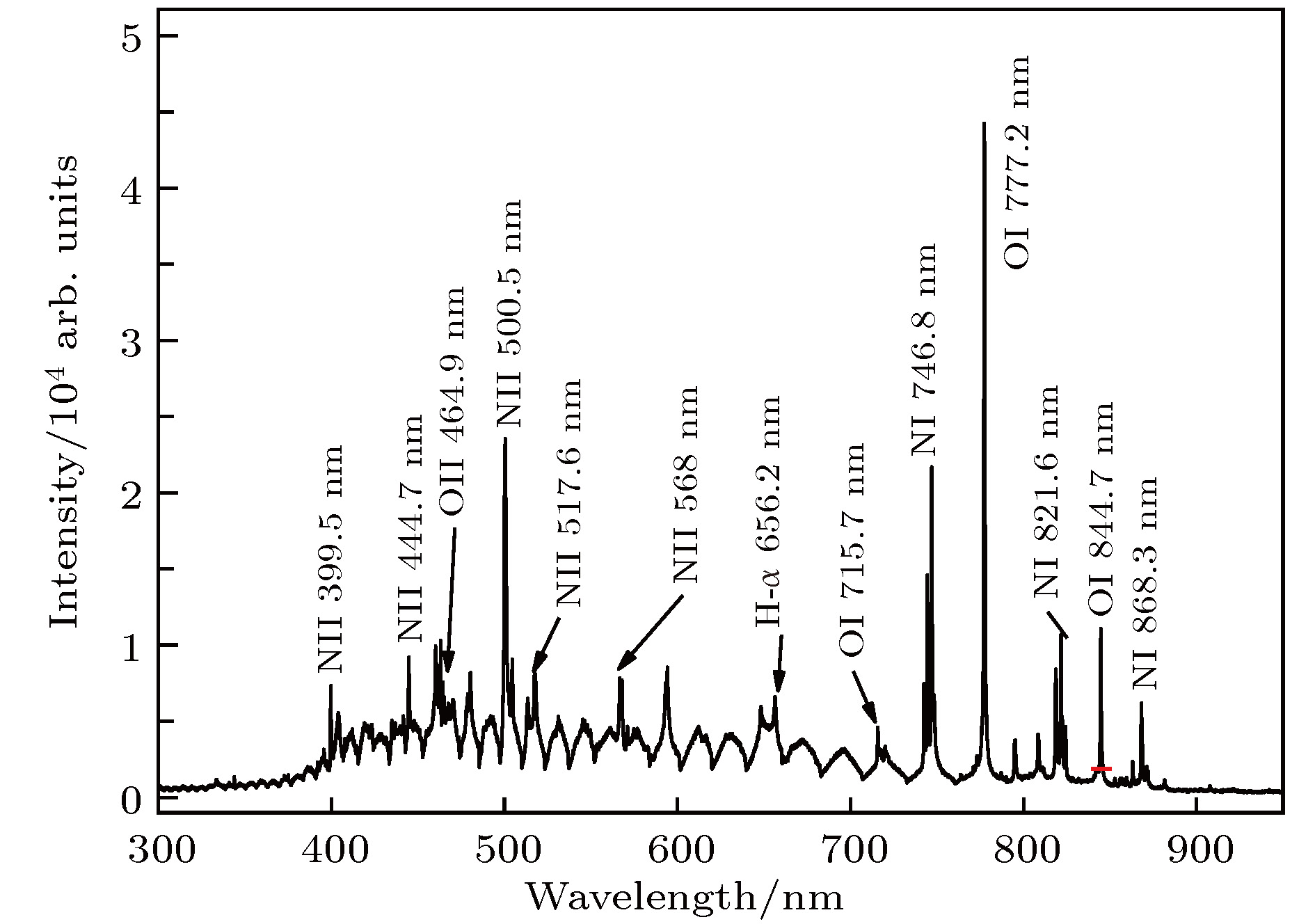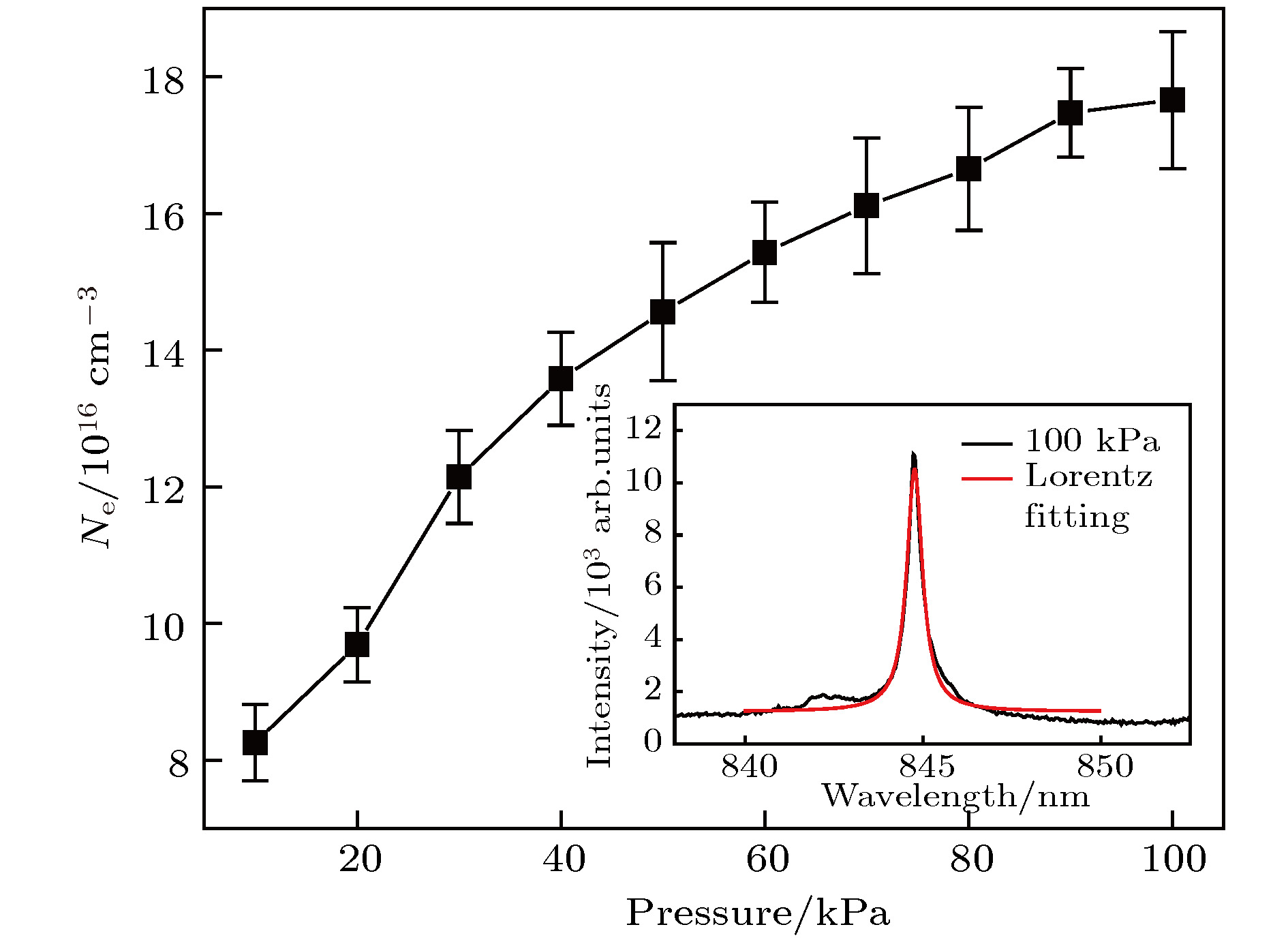-
环境气体的压强对激光诱导等离子体特性有重要影响. 基于发射光谱法开展了气体压强对纳秒激光诱导空气等离子体特性影响的研究, 探讨了气体压强对空气等离子体发射光谱强度、电子温度和电子密度的影响. 实验结果表明, 在10—100 kPa空气压强条件下, 空气等离子体发射光谱中的线状光谱和连续光谱依赖于气体压强变化, 且原子谱线和离子谱线强度随气体压强的变化有明显差别. 随着空气压强增大, 激光击穿作用区域的空气密度增加, 造成激光诱导击穿空气几率升高, 从而等离子体辐射光谱强度增大. 空气等离子体膨胀区域空气的约束作用, 增加了等离子体内粒子间的碰撞几率以及能量交换几率, 并且使离子-电子-原子的三体复合几率增加, 因此造成原子谱线O Ι 777.2 nm与N Ι 821.6 nm谱线强度随着气体压强增大而增大, 在80 kPa时谱线强度最高, 随后谱线强度缓慢降低. 而离子谱线N II 500.5 nm谱线强度在40 kPa时达到最大值, 气体压强大于40 kPa后, 谱线强度随压强增加而逐渐降低. 空气等离子体电子密度均随压强升高而增大, 在80 kPa后增长速度变缓. 等离子体电子温度在30 kPa时达到最大值, 气体压强大于30 kPa后, 等离子体电子温度逐渐降低. 研究结果可为不同海拔高度的激光诱导空气等离子体特性的研究提供重要实验基础, 为今后激光大气传输、大气组成分析提供重要的技术支持.The ambient gas pressure has an important influence on the laser induced plasma characteristics. The effects of gas pressure on the characteristics of air plasma induced by nanosecond laser are studied by using the optical emission spectroscopy, and the relationship between the gas pressure and the spectral intensity, and between electron temperature and electron density of air plasma are discussed. The air gas pressure in chamber is continuously changed in a range from 10 to 100 kPa by using a mechanical pump and measured by using a barometer. The ns laser energy in experiment is fixed at 100 mJ in the whole experiment. The digital delay trigger (Stanford DG535/645) is used to trigger the laser and ICCD synchronously, and the delay and gate time of ICCD are set to be 0 and 5 μs, respectively. The experimental results show that air plasma emission spectrum consists of the line and continuous spectrum, and the spectral intensity of air plasma emission spectrum is dependent on gas pressure in a range from 10 to 100 kPa, and the evolution of atomic spectrum intensity with gas pressure is different from that of ion spectrum intensity. The air density in the region of laser breakdown increases with air pressure increasing, which leads the breakdown probability of air gas to increase, thus resulting in the air plasma spectral intensity increasing. Under the confinement action of the ambient air gas in the expanding region of air plasma, the collision probability and energy exchange probability among particles in the air plasma are both increased, and the trisomic recombination probability of ion-electron-atom is also increased. As a result, the atomic spectral intensity of O Ι 777.2 nm and N Ι 821.6 nm both increase with the air gas pressure increasing, and the spectral intensity is highest at 80 kPa, and then slowly decreases. But the spectral intensity of N II 500.5 nm reaches its maximum value at 40 kPa, and decreases as the pressure becomes greater than 40 kPa. The electron density of the air plasma increases with the air pressure increasing, and the growth rate becomes slow after 80 kPa. The electron temperature of the air plasma reaches a maximum value at 30 kPa. The plasma electron temperature gradually decreases as the pressure becomes greater than 30 kPa. The research results can provide an important experimental basis for studying the laser-induced air plasma characteristics at different altitudes, and also give important technical support for laser atmospheric transmission and atmospheric composition analysis in the future.
-
Keywords:
- nanosecond laser /
- pressure /
- air plasma /
- three-body recombination
[1] Liu L, O′Sullivan G, O′Reilly F, Long E, Wang X, Dunne P 2017 Opt. Express 25 9974
 Google Scholar
Google Scholar
[2] Pandhija S, Rai N K, Rai A K, Thakur S N 2010 Appl. Phys. B 98 231
 Google Scholar
Google Scholar
[3] 张立文, 林晨, 辛立, 高军毅 2008 强激光与粒子束 20 1603
Zhang L W, Lin C, Xin L, Gao J Y 2008 High Power Laser and Particle Beams 20 1603
[4] Roskos H G, Thomson M D, Kreß M, Löffler A T 2007 Laser & Photonics Rev. 1 349
[5] Giacconi R 2003 Rev. Mod. Phys. 75 995
 Google Scholar
Google Scholar
[6] Ran P X, Hou H M, Luo S N 2017 J. Anal. At. Spectrom. 32 2254
 Google Scholar
Google Scholar
[7] Matsumoto A, Ohba H, Toshimitsu M, Akaoka K, Ruas A, Sakka T, Wakaida I 2018 Spectrochim.Acta. B 142 37
 Google Scholar
Google Scholar
[8] Hou H M, Yang B, Mao X L, Zorba V, Ran P X, Russo R E 2018 Opt. Express 26 13425
 Google Scholar
Google Scholar
[9] Skrodzki P J, Shah N P, Taylor N, Hartig K C, LaHaye N L, Brumfield B E, Jovanovic I, Phillips M C, Harilal S S 2016 Spectrochim. Acta. B 125 112
 Google Scholar
Google Scholar
[10] Sallé B, Cremers D A, Maurice S, Wiens R C 2005 Spectrochim. Acta. B 60 479
 Google Scholar
Google Scholar
[11] Rezaei F, Tavassoli S H 2015 Appl. Phys. B 120 563
 Google Scholar
Google Scholar
[12] Cowpe J S, Pilkington R D, Astin J S, Hill A E 2009 J. Phys. D: Appl. Phys. 42 165202
 Google Scholar
Google Scholar
[13] Bashir S, Farid N, Mahmood K, Rafique M S 2012 Appl. Phys. A 107 203
 Google Scholar
Google Scholar
[14] Bindhu C V, Harilal S S, Tillack M S, Najmabadi F, Gaeris A C 2003 J. Appl. Phys. 94 7402
 Google Scholar
Google Scholar
[15] Farid N, Harilal S S, Ding H, Hassanein A 2013 Appl. Phys. Lett. 103 191112
 Google Scholar
Google Scholar
[16] Liu D, Chen C S, Gao X, Lin J Q, Man B Y, Sun Y N, Li F F 2016 Eur. Phys. J. D 70 245
 Google Scholar
Google Scholar
[17] 刘小亮, 孙少华, 曹瑜, 孙铭泽, 刘情操, 胡碧涛 2013 物理学报 62 045201
 Google Scholar
Google Scholar
Liu X L, Sun S H, Cao Y, Sun M Z, Liu Q C, Hu B T 2013 Acta Phys.Sin. 62 045201
 Google Scholar
Google Scholar
[18] Nordstrom R J 1995 Appl. Spectrosc. 49 1490
 Google Scholar
Google Scholar
[19] 林兆祥, 李小银, 程学武, 李发泉, 龚顺生 2003 光谱学与光谱分析 23 421
 Google Scholar
Google Scholar
Lin Z X, Li X Y, Cheng X W, Li F Q, Gong S S 2003 Spectrosc.Spect. Anal. 23 421
 Google Scholar
Google Scholar
[20] Glumac N, Elliott G 2007 Opt. Laser. Eng. 45 27
 Google Scholar
Google Scholar
[21] Griem H R 1997 Principles of Plasma Spectroscopy (Cambridge: Cambridge University Press) p906
[22] Griem H R 1974 Spectral Line Broadening by Plasmas (New York: Academic Press) p335
[23] 邱德仁 2001 原子光谱分析 (上海: 复旦大学出版社) 第37—38页
Qiu D R 2001 Atomic Spectroscopy (Shanghai: Fudan University Press) pp37–38 (in Chinese)
-
表 1 激光大气等离子体主要线状谱线的归属情况
Table 1. Identification of the observed emission lines of N and O.
谱线种类 谱线位置/nm 跃迁形式 N+ 399.5 3p(1D) → 3s(1P0) N+ 444.7 3d(3D0) → 3p(3D) O+ 464.9 3p(4D0) → 3s(4P) N+ 500.5 3p(3S) → 3s(3P0) N+ 517.6 3d(5D) → 3p(5P0) N+ 568.0 3p(3D) → 3s(3P0) O 715.7 3p(1D2) → 3s($^1{\rm{D}}_2^0$) O 777.2 3p(5P) → 3s(5S0) N 821.6 3p(4P0) → 3s(4P) O 844.7 3p(3P) → 3s(3S0) N 868.3 3p(4D0) → 3s(4P) 表 2 氧原子谱线光谱信息
Table 2. Oxygen atomic line spectral information.
Wavelength/nm Em/eV En/eV Aki/s–1 gk O II 444.8 31.15 28.36 2.52×106 6 O Ι 844.6 10.99 9.52 3.22×107 3 -
[1] Liu L, O′Sullivan G, O′Reilly F, Long E, Wang X, Dunne P 2017 Opt. Express 25 9974
 Google Scholar
Google Scholar
[2] Pandhija S, Rai N K, Rai A K, Thakur S N 2010 Appl. Phys. B 98 231
 Google Scholar
Google Scholar
[3] 张立文, 林晨, 辛立, 高军毅 2008 强激光与粒子束 20 1603
Zhang L W, Lin C, Xin L, Gao J Y 2008 High Power Laser and Particle Beams 20 1603
[4] Roskos H G, Thomson M D, Kreß M, Löffler A T 2007 Laser & Photonics Rev. 1 349
[5] Giacconi R 2003 Rev. Mod. Phys. 75 995
 Google Scholar
Google Scholar
[6] Ran P X, Hou H M, Luo S N 2017 J. Anal. At. Spectrom. 32 2254
 Google Scholar
Google Scholar
[7] Matsumoto A, Ohba H, Toshimitsu M, Akaoka K, Ruas A, Sakka T, Wakaida I 2018 Spectrochim.Acta. B 142 37
 Google Scholar
Google Scholar
[8] Hou H M, Yang B, Mao X L, Zorba V, Ran P X, Russo R E 2018 Opt. Express 26 13425
 Google Scholar
Google Scholar
[9] Skrodzki P J, Shah N P, Taylor N, Hartig K C, LaHaye N L, Brumfield B E, Jovanovic I, Phillips M C, Harilal S S 2016 Spectrochim. Acta. B 125 112
 Google Scholar
Google Scholar
[10] Sallé B, Cremers D A, Maurice S, Wiens R C 2005 Spectrochim. Acta. B 60 479
 Google Scholar
Google Scholar
[11] Rezaei F, Tavassoli S H 2015 Appl. Phys. B 120 563
 Google Scholar
Google Scholar
[12] Cowpe J S, Pilkington R D, Astin J S, Hill A E 2009 J. Phys. D: Appl. Phys. 42 165202
 Google Scholar
Google Scholar
[13] Bashir S, Farid N, Mahmood K, Rafique M S 2012 Appl. Phys. A 107 203
 Google Scholar
Google Scholar
[14] Bindhu C V, Harilal S S, Tillack M S, Najmabadi F, Gaeris A C 2003 J. Appl. Phys. 94 7402
 Google Scholar
Google Scholar
[15] Farid N, Harilal S S, Ding H, Hassanein A 2013 Appl. Phys. Lett. 103 191112
 Google Scholar
Google Scholar
[16] Liu D, Chen C S, Gao X, Lin J Q, Man B Y, Sun Y N, Li F F 2016 Eur. Phys. J. D 70 245
 Google Scholar
Google Scholar
[17] 刘小亮, 孙少华, 曹瑜, 孙铭泽, 刘情操, 胡碧涛 2013 物理学报 62 045201
 Google Scholar
Google Scholar
Liu X L, Sun S H, Cao Y, Sun M Z, Liu Q C, Hu B T 2013 Acta Phys.Sin. 62 045201
 Google Scholar
Google Scholar
[18] Nordstrom R J 1995 Appl. Spectrosc. 49 1490
 Google Scholar
Google Scholar
[19] 林兆祥, 李小银, 程学武, 李发泉, 龚顺生 2003 光谱学与光谱分析 23 421
 Google Scholar
Google Scholar
Lin Z X, Li X Y, Cheng X W, Li F Q, Gong S S 2003 Spectrosc.Spect. Anal. 23 421
 Google Scholar
Google Scholar
[20] Glumac N, Elliott G 2007 Opt. Laser. Eng. 45 27
 Google Scholar
Google Scholar
[21] Griem H R 1997 Principles of Plasma Spectroscopy (Cambridge: Cambridge University Press) p906
[22] Griem H R 1974 Spectral Line Broadening by Plasmas (New York: Academic Press) p335
[23] 邱德仁 2001 原子光谱分析 (上海: 复旦大学出版社) 第37—38页
Qiu D R 2001 Atomic Spectroscopy (Shanghai: Fudan University Press) pp37–38 (in Chinese)
计量
- 文章访问数: 13306
- PDF下载量: 199
- 被引次数: 0














 下载:
下载:





